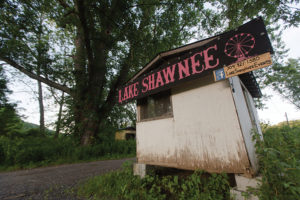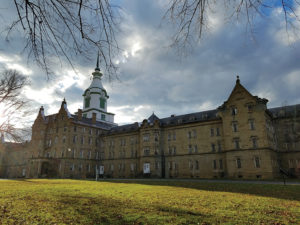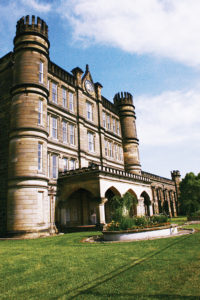By Samantha Cart
Beyond its beautiful mountains and breathtaking overlooks, West Virginia is home to something a bit more ominous—a variety of haunts said to make the hair stand up on the necks of even the staunchest skeptics. Whether or not you believe in the supernatural, the dark history of these locations is undeniable, and it is that history and notoriety that keep natives and tourists alike coming back for more. From the Trans-Allegheny Lunatic Asylum’s rumored mistreatment of patients to the West Virginia State Penitentiary’s long line of violent offenders and the trail of mysterious deaths at Lake Shawnee Amusement Park, these sinister locations add a fresh take on the Mountain State’s unique tourism industry.
Lake Shawnee Amusement Park
Photo by Visit Mercer County WV
 Built on the remains of a Native American burial ground, Lake Shawnee Amusement Park has a dark, violent past. In the late 1700s, Mitchell and Phoebe Clay, one of the first families to live in Mercer County, settled on the 800-acre farm that is now Lake Shawnee. In 1783, a Native American tribe killed two of their 14 children and kidnapped a third, Ezekiel, who was burned at the stake. Mitchell retaliated with the help of other Mercer County settlers and killed several members of the Native American tribe, an act that some say scarred the land.
Built on the remains of a Native American burial ground, Lake Shawnee Amusement Park has a dark, violent past. In the late 1700s, Mitchell and Phoebe Clay, one of the first families to live in Mercer County, settled on the 800-acre farm that is now Lake Shawnee. In 1783, a Native American tribe killed two of their 14 children and kidnapped a third, Ezekiel, who was burned at the stake. Mitchell retaliated with the help of other Mercer County settlers and killed several members of the Native American tribe, an act that some say scarred the land.
In the 1920s, Conley Snidow bought the property to open an amusement park, which he named Lake Shawnee. It wasn’t long until things started going wrong.
“Snidow had at least three deaths, but we’re thinking there are more because people still come to me and tell me stories,” says Chris White, the current owner of Lake Shawnee. “One little boy drowned in the lake, then a little boy drowned in the pond, and then there was the little girl that died on the swings.”
Abandoned in 1966, the park was purchased in the early 1980s by businessman Gaylord White, Chris’ father, for community lot space. Construction came to a halt, though, after crews unearthed Native American bones and artifacts archaeologists believe were there long before the Clay family.
The White family decided to leave the burial ground and rides intact and continued to run Lake Shawnee as an amusement park from 1986-1988. Today, the site is renowned as a mecca of the supernatural. The park has attracted ghost hunters and paranormal experts from all over the world and was named one of the 10 Most Haunted Places in the World by ABC.
While visitors can schedule private tours and paranormal investigations, the park’s main event is the Dark Carnival, which is held every October. For more information on upcoming events, visit www.visitmercercounty.com/lakeshawnee.
Trans-Allegheny Lunatic Asylum
 The Trans-Allegheny Lunatic Asylum (TALA) is one of the most easily recognized haunts in America. Ghost hunters have traveled from all over to explore the dark halls of this historic landmark, searching for the sources of apparitions and bodiless voices.
The Trans-Allegheny Lunatic Asylum (TALA) is one of the most easily recognized haunts in America. Ghost hunters have traveled from all over to explore the dark halls of this historic landmark, searching for the sources of apparitions and bodiless voices.
TALA, which operated from 1864-1994, was home to the mentally ill as well as many misunderstood populations, including children and adults with Down syndrome, diabetes, epilepsy and eccentric personalities and even disabled veterans.
After the asylum closed, many development ideas were created for the property, including plans for a resort, hotel and casino. Joe Jordan purchased the asylum in 2007, and his daughter, Rebecca Jordan-Gleason, is the current operations manager.
“Set on preserving the National Historic Landmark, the Jordan family opened the building for tours to raise funds,” says Bethany Cutright, office manager at TALA. “The first tour season in 2008 brought 7,000 visitors to the grounds, and in 2016, we welcomed almost 70,000.”
The asylum has attracted national attention from celebrity ghost hunters. Investigators from the popular TV shows “Ghost Hunters,” “Ghost Adventures” and “Paranormal Lockdown” have aired their experiences of trying to make contact with the spirits that reportedly reside in the building.
The staff is not immune to these experiences. “Most often, I hear things—voices, footsteps—that cannot be explained,” says Cutright. “Sometimes it is a shadow or a glimpse of something out of the corner of your eye. The building has a looming presence that speaks volumes, and thousands of souls passed through those wards. If there was ever a place with paranormal possibilities, this would be it.”
TALA offers paranormal and historic tours and hosts a variety of other activities on-site to raise funds for restoration and preservation, including zombie paintball and its legendary haunted house every fall. To learn more about schedules and events, visit www.trans-alleghenylunaticasylum.com.
West Virginia State Penitentiary
Photo by Michelle Kelly
 Inspired by the Joliet Correctional Center in Illinois, construction on the West Virginia State Penitentiary began in 1866. The imposing stone structure housed violent criminals, and its history is punctuated with bloody riots and escaped convicts.
Inspired by the Joliet Correctional Center in Illinois, construction on the West Virginia State Penitentiary began in 1866. The imposing stone structure housed violent criminals, and its history is punctuated with bloody riots and escaped convicts.
The prison was named to the U.S. Department of Justice’s Top 10 Most Violent Correctional Facilities at one point due to the approximately 1,000 men that died there via execution, suicide or murder. While punishment styles changed over time, many prisoners were executed and buried on the grounds of the penitentiary. “Old Sparky,” the electric chair that carried out executions until 1965, is still on display.
According to Suzanne Park, executive director of the Moundsville Economic Development Council, North Hall housed the infirmary, dental office and psych ward as well as the worst of the worst inmates. “You were put in North Hall for crimes committed inside the prison,” she says.
Inmate R.D. Wall suffered at the hands of prison hierarchy in North Hall in 1929 as one of 36 known homicides at the facility. “The inmates considered him a snitch,” says Park. “He was sitting on the commode, and they went in and bludgeoned him to death.”
A former indoor recreation area inside the penitentiary nicknamed the Sugar Shack by inmates, which was a den of gambling, fighting, rape and murder, was another hotspot for violence. “The Sugar Shack was in the basement, and there were areas where an inmate could push another inmate around the corner and stab him,” she says.
Today, the penitentiary hosts a variety of events, including private paranormal investigations, twilight tours and a haunted house every October. This spring, the penitentiary plans to open its second escape room. For more information on tours and events, visit www.wvpentours.com.









One Response
Are there any old plantation in west Virginia?